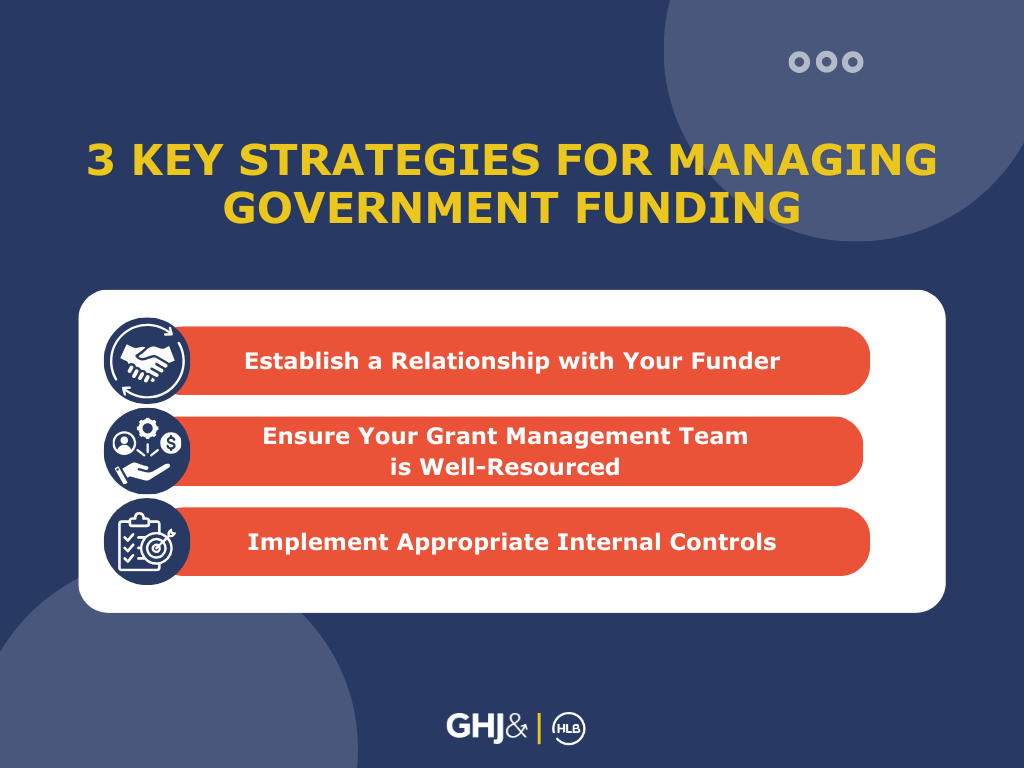Navigating government contracts may feel like finding one’s way through a labyrinth — not only do recipients have to run
an effective program, but they also need to ensure compliance with a myriad of reporting, billing and accounting requirements.
In working with many government-funded nonprofits, GHJ’s Nonprofit Practice sees three key strategies that help ensure success: having a strong relationship with the funder, establishing a well-resourced grant management team and implementing a system of effective internal controls.
ESTABLISH A RELATIONSHIP WITH THE FUNDER
Building rapport with key funder contacts is invaluable for maintaining compliance with the terms of the contract:
- Clarification and Support: Being able to request additional information and resources is critical to managing a government contract. One of the biggest challenges GHJ sees, especially with pass-through funding, is that pass-through entities include additional requirements that may be missed by the subrecipients or make program management more difficult. For example, a contract may prescribe overly restrictive guidelines on who can be served by the program that are hard to implement in practice. Entities with a close relationship with their funder can reach out with questions about the terms and conditions and avoid potential noncompliance. It is always better to preempt mistakes rather than be surprised at the end with disallowed costs and denied billings.
- Guidance on Changes: Unclear guidance or subsequent changes in funding sources pose another common challenge. At times recipients are not notified of the federal character of funding until after year-end, at which point they have to go back and ensure appropriate compliance requirements have been followed. They may also have the unpleasant surprise of being subject to a single audit as a result of a subsequent reallocation of funds. Grant management teams should carefully read contracts to ensure a complete understanding of the terms. In cases of funding source ambiguities, they should reach out to the funder early on for written clarification.
- Negotiation Leverage: Having a strong relationship with the funder may also help in negotiating favorable terms before the contract signing. Standard contract forms may impose minimum indirect cost rates and disallow specific cost items, and adhering to such terms would prevent the nonprofit recipient from recovering the full costs of managing the contract. It never hurts to try and negotiate the terms with the pass-through entity, since adequate reimbursement would ensure the program can be run effectively and consistently.
Overall, treating the relationship with the funder as a collaborative partnership is essential for effectively managing the program.
ENSURE THE GRANT MANAGEMENT TEAM IS WELL-RESOURCED
In recent years, many nonprofits received significant increases in government grant funding. At the same time, the
y have also experienced substantial volumes of turnover in their finance teams, which commonly led to a lack of segregation of duties and loss of operational program knowledge. Both of these factors, coupled with a lack of investment in technology, have created a perfect storm when it comes to compliance with the terms and provisions of government contracts, and nonprofits have struggled to keep up.
As a result, as part of the grant acceptance process, it is important to conduct a comprehensive assessment of the following to make sure the team is equipped to manage the governmental funding received:
- Is the right talent in place, and is the team large enough to handle the programs? Depending on the volume and complexity of the governmental contracts received, it may be necessary to have a designated grant management team. This team should have the appropriate background in the types of government contracts the organization receives and have access to regular training on agency updates and compliance requirements at the Uniform Guidance, state and other specific award levels.
- Are the right tools in place to track program activity and performance? The technology should match the complexity of the contract requirements. Key systems should cover claims billing, staff time and effort tracking by program, as well as cost accumulation and allocation in separate cost centers within the general ledger system.
- Are the right processes for knowledge sharing in place? Those responsible for grants management should have early access to grant contracts, amendments and other communications. They should also have contacts at the funders to be able to ask clarifying questions.
The above items should be reevaluated regularly and at the very least with each new significant contract and team member turnover.
IMPLEMENT APPROPRIATE INTERNAL CONTROLS
With the focus on prudent spending of federal and state funding, it is no surprise that funding recipients are subject to high expectations when it comes to internal controls. The following key internal control areas are critical:
- Written Policies Requirement: If federal funding is received, Uniform Guidance requires that certain policies are put in writing, including policies on procurement, payment and cash management, conflict of interest and cost allocation. Overall, it is best to document all key internal controls policies to avoid miscommunication and to help with cross-training the team.
- Time and Effort Compliance: Time and effort reporting is an area of focus for federal agencies and pass-through entities, and Code of Federal Regulations (CFR) Title 2, § 200.430, Compensation—Personal Services is a good place to start when looking to identify what is required. Funders generally require that compensation costs charged to contracts reflect actual work performed at rates that are reasonable and consistent with the organization’s overall compensation policies. A robust system that tracks time worked is vital — this includes time sheets identifying time worked by program or other documentation such as timely updated and reviewed tracking logs, job descriptions for non-shared staff, certifications, etc. Budget estimates that are not reviewed and trued up are generally not considered sufficient support.
- Cost Allocation: Cost allocation policies are another complex area in managing grant funding. Ensure costs are consistently charged as either indirect or direct and are not double charged, and ensure costs comply with the agreed-upon budget and indirect cost rate established in the contract. Supporting calculations and analysis of costs charged to specific awards should be retained.
Once internal control policies are designed, they should be regularly reevaluated to ensure policies are up-to-date based on current team composition and changes in federal and state guidelines and incorporate adequate segregation of duties over key accounting functions.
The successful management of government funding requires the leadership team to focus on funder relationships, appropriate human and technology resources and a robust system of internal controls. Regular evaluation of these three key strategies is critical to avoiding potential noncompliance in light of evolving regulations and organizational changes.
To learn more about how nonprofits can set themselves up for success, please contact GHJ’s Nonprofit Practice.



